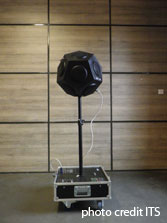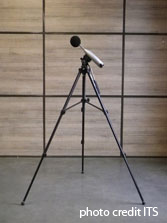General considerations in relation to the measurement of the spatial sound decay in a room
A value of the spatial decay of the sound pressure level by doubling the distance too small (illustrating excessive sound waves reflections reverberation phenomena e.g. on hard surfaces) can impair the acoustic comfort in some spaces (given their intended purpose) and (in some cases) conformity e.g. in work premises:
- shared offices (e.g. open spaces)
- dining rooms
In France, the measurement of the spatial sound decay in a room is carried out in accordance with the appendix of the Decree of august 1990 the 30th used for the implementation of the article R. 235-11 of the Labor code and related to the reverberation limitation of working premises or with the standard (which is often preferred) ISO 14257 Acoustics – Measurement and parametric description of spatial sound distribution curves in workrooms for evaluation of their acoustical performance.
Practical aspects in relation to the measurement of the spatial sound decay in a room
- production of the acoustic field: the acoustic field is usually produced by an omnidirectional pink noise source
- measuring equipment: the acoustic measuring equipment generally consists of a sound level meter (with a microphone) and of a calibrator

ITS omnidirectionnal noise source for room spatial sound decay measurement |

ITS sonometer for room spatial sound decay measurement |
- transfer and analysis software: a transfer and analysis software is generally used, allowing a deferred exploitation of recordings carried out on site
- evaluation of sound spatial decay: this is the difference in decibels between the sound pressure level in a given octave band and for a microphone position located at a given distance from the reference sound source and the sound power level of the reference sound source in the same octave band
- determination of the spatial decay of the sound pressure level by doubling the distance: this is the slope, in decibels, of the spatial sound decay curve in a given range, when the source distance doubles
Qualitative aspects relating to the measurement of spatial sound decay in a room
Depending on the size of the premises, the quality of the spatial sound decay measurements may require, for the noise generator, a set of loudspeakers:
- omnidirectional, then installed at a height compatible with the presence of furniture (e.g. in an open space)
- forming a half-sphere, then placed on the ground
For quality spatial sound decay measurements:
- the sound level meter used must be duly calibrated and verified
- nothing beats a technician experienced in physical measurements, specialized in instrumental techniques who will be able to choose, for the best possible determination of the DL [1] parameter:
- the most appropriate areas for the positioning of the noise generator and the microphone sensors
- the best measurement paths, in adequate numbers and with as many ideally spaced points as desired
- the best after-treatment of recordings of emission/reception measurements of sound signals
Of course, that an acoustician with a degree in building physics can be able, within the framework of an acoustics engineering mission, to analyze the results of measurements of the spatial sound decay of premises and not only to adopt a position on conformity, but also to propose initiatives for actions aimed at improving the situation, and that he also - as at ITS - has solid experience in solving problems of noise reduction and improvement of acoustic comfort is a definite advantage.
ITS masters all aspects of spatial sound decay measurements in a room, with services whose quality is regularly assessed and certified in accordance with the requirements of the standard ISO 9001.
Spread the word !
[1] spatial sound decay rate, expressed in dB(A) per doubling of distance (with respect to a reference sound spectrum)